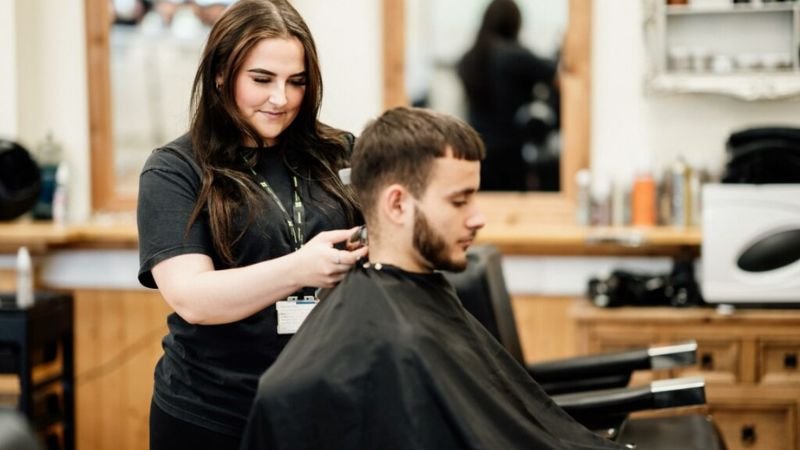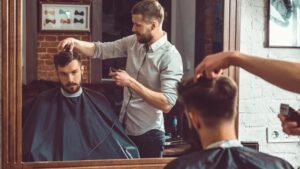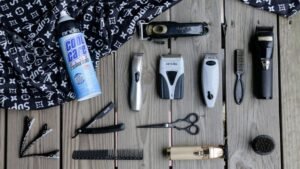Advanced Barbering Techniques for Creating Detailed Hairline Designs = Creating sharp, intricate hairline designs requires more than basic barbering skills. Mastering advanced barbering techniques is essential for barbers aiming to craft detailed, stylish hairlines that stand out.
From precise clipper work to expert fading methods, these techniques allow for creativity and precision, transforming a simple cut into a work of art.
In this article, we explore the “7 Best Advanced Barbering Techniques for Creating Detailed Hairline Designs,” designed to elevate your skills and keep your clients returning for that polished, custom look.
Whether you’re a seasoned barber looking to refine your craft or a beginner eager to learn, these techniques cover everything from using the right tools to executing flawless line-ups and patterns. Dive in to discover the key skills every barber needs to master to create eye-catching, intricate hairline designs that leave a lasting impression.
Advanced Barbering Techniques for Creating Detailed Hairline Designs
1. Mastering Precision Clipper Control
Achieving detailed hairline designs starts with mastering your clipper control. Precision is key in creating sharp, clean lines that stand out. This involves understanding the different clipper settings and how they affect the cut. The key to mastering clipper control is consistent practice with different angles and pressure points.
For intricate hairline designs, start by using a zero-gap clipper for ultra-close cuts. The sharper the tool, the more precise the lines will be. It’s also crucial to control speed while working steadily with your hand. Faster strokes might be good for bulk cutting, but for detailed hairlines, slow, deliberate movements ensure accuracy.
The difference between a good and a great design often lies in the clean, crisp edges that come with excellent clipper control. To further enhance precision, experiment with different blade sizes and guards, depending on the desired thickness and sharpness of the line.
Regularly practicing fades, curves, and defined angles using your clippers will also build confidence, allowing for more complex designs. Ultimately, the goal is to gain full mastery over your clippers, transforming them into a tool that follows your creative vision effortlessly.
2. Advanced Razor Line-Up Techniques
Razor line-ups are crucial for barbers looking to deliver flawless, detailed hairline designs. While clipper work is effective, using a straight razor for the finishing touches adds a level of sharpness and definition that’s unmatched.
This technique involves carefully tracing the hairline with a razor blade to create clean, crisp edges that stand out. The key is to use the razor at a slight angle, allowing for smooth cuts without digging into the skin. When executing a razor line-up, maintaining a light touch is critical.
Too much pressure can cause cuts or skin irritation, while a too-gentle hand may not achieve the desired definition. Also, always ensure the razor blade is fresh and sharp to avoid dragging or pulling at the skin. Prepping the skin is also an essential part of the process.
Apply a warm towel to soften the skin and hair, followed by a shaving gel or cream that allows the razor to glide smoothly. For more intricate hairline designs, break the design into smaller segments and work on one section at a time. This makes greater control and improved outcomes possible.
Regular practice with razor techniques ensures you can offer clients razor-sharp, flawless designs that last longer and stand out.
3. Creative Freehand Designs
The ability to create freehand designs is a game-changer for barbers specializing in detailed hairline work. Unlike standard cuts, freehand designs rely entirely on the barber’s creativity and skill. This technique involves visualizing a pattern or design and executing it without the use of stencils or guides.
Freehand designs are often used to create unique, custom patterns along the hairline, ranging from geometric shapes to flowing curves. The first step in perfecting freehand techniques is building confidence in your vision and translating that into clean, precise cuts.
Start by sketching out designs on paper to train your hand in the motions and angles you’ll need to replicate on a client’s scalp. Once comfortable, practice these designs on mannequins or willing clients, focusing on symmetry and proportion. Another crucial aspect of freehand design is understanding hair growth patterns and how they can be used to your advantage.
For instance, aligning curves with the natural grain can enhance the flow of the design. Freehand work also demands impeccable linework, so combining this technique with razor line-ups and detailed clipper control can produce truly eye-catching results. As you refine your freehand abilities, you’ll be able to offer bespoke designs that set your services apart in a crowded market.
Also Read: Handling Difficult Clients and Ensuring Satisfaction in a Barbershop: 7 Tips
4. Perfecting the Fade for Seamless Blends
A flawless fade is foundational for advanced hairline designs. When it comes to detailed designs, a smooth, seamless blend between different lengths is vital. The fade acts as the backdrop, allowing the design to stand out more prominently.
A common mistake barbers make is rushing through the fading process, leading to uneven transitions that can detract from the overall design. To perfect a fade, focus on gradual blending, moving from shorter lengths at the base to longer ones toward the crown, without visible lines or demarcations.
Start with the largest guard and work your way down to the smallest, gradually reducing the guard size to create a consistent blend. Using a variety of clipper techniques such as the “clipper-over-comb” method can also help in achieving a smooth transition.
Another key factor is understanding head shape and hair density. Areas with denser hair might require additional tapering to achieve a balanced look. For more complex designs, incorporating skin fades can add contrast, making the design pop.
The goal is to create a smooth canvas where your detailed line work and patterns can be highlighted effectively. Mastering this technique not only elevates your designs but also builds your reputation as a skilled barber who pays attention to detail.
5. Utilizing Hairline Pencils for Enhanced Precision
Hairline pencils are an underrated tool in creating detailed hairline designs. These pencils are often used to outline the hairline before cutting, offering a clear guide for intricate work. For beginners, hairline pencils are especially helpful in planning the design and ensuring symmetry before making any cuts.
Simply draw the desired hairline or pattern using the pencil, then follow those lines closely with your clippers or razor. The result is a more precise and symmetrical design, particularly useful for more intricate patterns or when creating sharp edges.
In addition to outlining, hairline pencils can also be used as a final touch to make designs pop. By slightly highlighting the edges after the cut, you add contrast, making the lines appear sharper and more defined. To avoid an overly artificial look, use a pencil that matches the client’s hair color and blend the edges for a natural finish.
Combined with proper fading and line-up techniques, hairline pencils can elevate your hairline designs from standard to professional-grade. As you become more comfortable using them, you’ll find that they are a versatile tool in your arsenal, perfect for those looking to offer highly detailed and polished designs.
6. Incorporating Hair Tattoo Techniques
Hair tattooing is an advanced technique that combines barbering skills with artistic talent. Also known as hair etching, this technique involves carving intricate patterns or designs into the scalp, creating a tattoo-like effect using clippers and razors.
Hair tattoos can range from simple line designs to complex images, and they offer endless opportunities for creativity. The ability to tattoo hair precisely and steadily is essential for success. Start with a clear vision or pattern, often sketched out beforehand, and then carefully etch it onto the client’s scalp.
This technique often requires using multiple tools, including fine-toothed trimmers for outlining and razors for detailing. Patience is crucial, as rushing through the process can lead to mistakes that are difficult to correct. Additionally, hair tattoo designs tend to be more visible in shorter hair, so make sure the client’s hair is trimmed to an appropriate length for maximum impact.
Incorporating fades and gradients within the design can add depth and dimension, making the pattern more dynamic. Regularly practicing this technique will enhance your ability to offer one-of-a-kind designs that go beyond traditional haircuts, setting you apart as an artist in the barbering world.
7. Advanced Use of Hair Fibers and Enhancement Sprays
In the realm of advanced barbering, hair fibers and enhancement sprays have become go-to tools for creating highly defined hairline designs. These products are especially useful when dealing with clients who have thinning hair or uneven hairlines.
Hair fibers are tiny particles that cling to the existing hair, making it appear fuller and thicker, while enhancement sprays add a temporary, natural-looking layer of color that sharpens the hairline. The advanced use of these products requires understanding how to apply them effectively without creating an unnatural look.
Before using fibers or sprays, make sure the hair and scalp are clean and dry. Use a light hand to apply the product in small amounts, gradually building it up for a more natural finish. To enhance the effect, combine these products with precise clipper and razor work.
To provide a crisp, clean finish after applying fibers or spray, redefine the edges with a razor. This technique not only enhances the overall look but also extends the lifespan of the design. Hair fibers and sprays are particularly useful for high-definition hairlines or when showcasing a new design on social media. Mastering these products allows you to deliver consistent, polished results that your clients will love.
These techniques, when mastered, can take your barbering skills to the next level, enabling you to create detailed hairline designs that stand out in a competitive industry. Whether you’re enhancing precision, adding creative flair, or offering unique designs, these methods are essential for any barber looking to elevate their craft.
Conclusion
Mastering advanced barbering techniques for hairline designs takes practice, precision, and creativity. By implementing these seven techniques, you can enhance your skill set, offer unique designs, and set yourself apart in the competitive barbering industry.
From mastering the right tools to perfecting your fading and lining techniques, consistent practice and attention to detail are the keys to success. As trends evolve, staying updated with the latest skills ensures you continue delivering fresh, stylish designs that keep clients satisfied and loyal. Embrace these techniques, and watch your barbering business thrive.
FAQs
What tools are essential for advanced hairline designs?
The essentials include professional clippers, trimmers with sharp blades, detailers, and hairline pencils for precise outlines.
How can I improve my fading technique for hairline designs?
Practice using gradual blending, ensure proper clipper control, and study different fading styles to create seamless transitions and sharp details.




